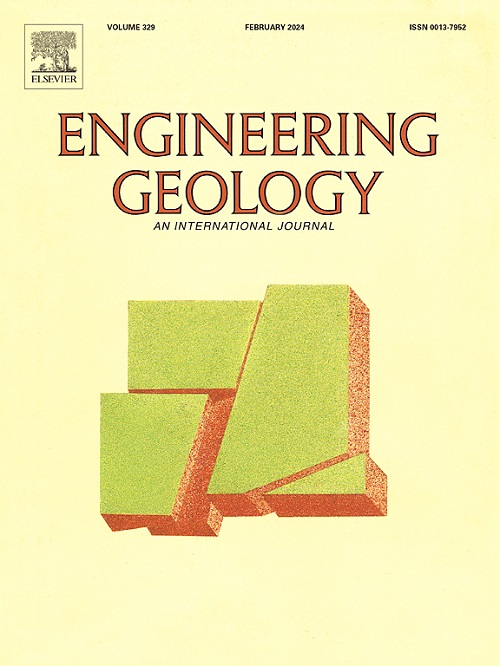Investigating the frost cracking mechanism and the related shallow alpine rockfall initiation process using three-dimensional FDEM
IF 8.4
1区 工程技术
Q1 ENGINEERING, GEOLOGICAL
引用次数: 0
Abstract
Frost weathering plays a critical role in rockwall instability in alpine environments. This paper offers a new insight into the shallow alpine rockfall mechanism from the frost cracking perspective. A numerical framework based on the three-dimensional (3D) combined finite discrete element method (FDEM) is developed to simulate the cryogenic thermal-mechanical coupled processes in cold regions (e.g., water-ice phase change, ice-rock interaction, and frost cracking). Specifically, a new volume expansion model is introduced, allowing for explicit ice-rock interaction in pre-existing cracks while implicit frost heaving pressure in pores or newly generated cracks, to improve numerical efficiency and stability. This framework is validated against benchmark tests and further applied to explore the shallow alpine rockfall mechanism under repeated freeze-thaw cycles. Results suggest that the proposed method effectively simulates temperature field evolution and frost cracking process in cold regions. Frost crack initiation, propagation, and connection with pre-existing cracks, driven by ice-rock interaction in cold seasons, deteriorate structure stability and prepare/trigger shallow rockfall. This study enriches the shallow rockfall mechanism from fracture mechanics standpoint, which is essential for assessing, predicting, and mitigating rockfall activity, particularly in the context of global climate change.
利用三维FDEM研究了浅高寒岩崩的冻裂机理和起裂过程
霜冻风化对高寒环境下岩壁失稳起着至关重要的作用。本文从冻裂的角度对浅高寒岩崩机理进行了新的认识。建立了基于三维联合有限离散元法(FDEM)的数值框架,用于模拟寒区低温热-力耦合过程(如水-冰相变、冰-岩相互作用和霜裂)。具体来说,引入了一种新的体积膨胀模型,允许在已有裂缝中显式地进行冰岩相互作用,而在孔隙或新产生的裂缝中隐式地进行冻胀压力,以提高数值计算的效率和稳定性。通过基准试验验证了该框架的有效性,并进一步应用于反复冻融循环下浅高寒岩崩机制的研究。结果表明,该方法能有效模拟寒冷地区的温度场演化和霜冻开裂过程。在寒冷季节,冰-岩相互作用驱动下,霜裂缝的萌生、扩展和与原有裂缝的连接,破坏了结构的稳定性,并准备/触发了浅层岩崩。该研究从断裂力学的角度丰富了浅层岩崩机制,对评估、预测和减轻岩崩活动具有重要意义,特别是在全球气候变化的背景下。
本文章由计算机程序翻译,如有差异,请以英文原文为准。
求助全文
约1分钟内获得全文
求助全文
来源期刊

Engineering Geology
地学-地球科学综合
CiteScore
13.70
自引率
12.20%
发文量
327
审稿时长
5.6 months
期刊介绍:
Engineering Geology, an international interdisciplinary journal, serves as a bridge between earth sciences and engineering, focusing on geological and geotechnical engineering. It welcomes studies with relevance to engineering, environmental concerns, and safety, catering to engineering geologists with backgrounds in geology or civil/mining engineering. Topics include applied geomorphology, structural geology, geophysics, geochemistry, environmental geology, hydrogeology, land use planning, natural hazards, remote sensing, soil and rock mechanics, and applied geotechnical engineering. The journal provides a platform for research at the intersection of geology and engineering disciplines.
 求助内容:
求助内容: 应助结果提醒方式:
应助结果提醒方式:


